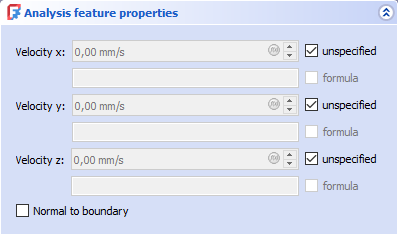FEM ConstraintFlowVelocity/de
|
|
| Menüeintrag |
|---|
| Model → Fluid-Randbedingungen → Randbedingung Strömungsgeschwindigkeit |
| Arbeitsbereich |
| FEM |
| Standardtastenkürzel |
| Keiner |
| Eingeführt in Version |
| - |
| Siehe auch |
| StartbedingungStrömungsgeschwindigkeit |
| Gleichungslöser |
|---|
| Elmer |
Beschreibung
Ordnet einer Kante in 2D oder einer Fläche in 3D eine Strömungsgeschwindigkeit als Grenzbedingung zu.
Das FEM-Strömungsgeschwindigkeits-Aufgaben-Fenster
Anwendung
- Es gibt mehrere Möglichkeiten, den Befehl aufzurufen:
- Die Schaltfläche
Grenzbedingung für die Strömungsgeschwindigkeit drücken.
- Die Option Modell → Fluid-Randbedingungen →
Grenzbedingung für die Strömungsgeschwindigkeit aus dem Menü wählen.
- Die Schaltfläche
- Die Schaltfläche Hinzufügen drücken.
- Die Zielobjekte auswählen. eingeführt in 1.1: Um Objekte aus der Auswahl zu entfernen, auf die Schaltfläche Entfernen klicken.
- unspecified deaktivieren, um die erforderlichen Felder für die Bearbeitung zu aktivieren.
- Die Geschwindigkeitswerte festlegen oder (eingeführt in 0.21) eine Formel angeben.
Formeln
Es ist möglich eine Geschwindigkeit festzulegen, durch Angabe des Geschwindigkeitsprofils als Formel. In diesem Falle verwendet der Löser die Geschwindigkeiten an den unterschiedlichen Stellen dem Profil entsprechend.
Als Beispiel für die Festlegung des Geschwindigkeitsprofils
für (unter Annahme, dass z.B. eine Leitung die Wand bei y = 1 m und y = 2 m hat)
gibt man dies in das Feld Formula ein:
Variable Coordinate 2; Real MATC "6*(tx-1)*(2-tx)"
Dieser Code hat die folgende Syntax :
- Das Präfix Variable legt fest, dass die Geschwindigkeit keine Konstante sondern eine Variable ist.
- Die Variable für die Berechnung der Geschwindigkeit ist Coordinate 2, also y.
- Die Geschwindigkeitswerte werden als Real (Fließkommazahl) zurückgegeben.
- Das Präfix MATC zeigt dem Löser Elmer an, dass der folgende Code eine Formel ist.
- tx ist immer der Name der Variable in MATC-Formeln, auch wenn in unserem Falle tx eigentlich y ist.
Dieses y gilt nur in dem Intervall , da MATC nur das tx-Intervall auswertet, in dem das Ergebnis positiv ist. Dieses Verhalten ist etwas ungewöhnlich, hat aber den Vorteil, dass man das Intervall nicht von Hand festlegen muss.
Es ist auch möglich, mehr als eine Variable zu verwenden. Siehe z.B. die Festlegung von Drehungen unter Randbedingung Versatz.
Hinweise
- Jede Vektorkomponente, die das Ergebnis des Lösers sein soll, muss als Unspecified (Nicht spezifiziert) festgelegt werden.
- Wenn die Zielfläche oder -kante nicht mit dem kartesischen Hauptkoordinatensystem ausgerichtet ist, kann die Option Normal to boundary (Normal zur Grenze) festgelegt werden.
- Wenn Normal zur Grenze aktiviert ist, ist der Normalenvektor zur ausgewählten Kante oder Fläche X und wird vom Netzbereich weg ausgerichtet.
- Wenn beispielsweise ein Luftstrom von 20 mm/s in den Bereich eintreten soll, muss bei Normal zur Grenze im Feld Geschwindigkeit x -20 mm/s eingegeben werden.
- Für eine Wand mit rutschfesten Eigenschaften setzt man alle Geschwindigkeitskomponenten auf 0.
- Für eine Symmetriebedingung setzt man den Fluss auf (0, Nicht angegeben, Nicht angegeben), wenn Normal zur Grenze aktiviert ist.
- Materials: Solid Material, Fluid Material, Non-Linear Mechanical Material, Reinforced Material (Concrete); Material Editor
- Element Geometry: Beam Cross Section, Beam Rotation, Shell Plate Thickness, Fluid Section for 1D Flow
- Electromagnetic Boundary Conditions: Electrostatic Potential Boundary Condition, Current Density Boundary Condition, Magnetization Boundary Condition, Electric Charge Density
- Fluid Boundary Conditions: Initial Flow Velocity Condition, Initial Pressure Condition, Flow Velocity Boundary Condition
- Geometrical Analysis Features: Plane Multi-Point Constraint, Section Print Feature, Local Coordinate System
- Mechanical Boundary Conditions and Loads: Fixed Boundary Condition, Rigid Body Constraint, Displacement Boundary Condition, Contact Constraint, Tie Constraint, Spring Boundary Condition, Force Load, Pressure Load, Centrifugal Load, Gravity Load
- Thermal Boundary Conditions and Loads: Initial Temperature, Heat Flux Load, Temperature Boundary Condition, Body Heat Source
- Overwrite Constants: Constant Vacuum Permittivity
- Mesh: Mesh From Shape by Netgen, Mesh From Shape by Gmsh, Mesh Boundary Layer, Mesh Refinement, Mesh Group, Erase Elements, FEM Mesh to Mesh
- Solve: Solver CalculiX, Solver Elmer, Solver Mystran, Solver Z88; Mechanical Equations: Elasticity Equation, Deformation Equation; Electromagnetic Equations: Electrostatic Equation, Electricforce Equation, Magnetodynamic Equation, Magnetodynamic 2D Equation, Static Current Equation; Flow Equation, Flux Equation, Heat Equation, Solver Job Control, Run Solver
- Results: Purge Results, Show Result, Apply Changes to Pipeline, Post Pipeline From Result, Pipeline Branch, Warp Filter, Scalar Clip Filter, Function Cut Filter, Region Clip Filter, Contours Filter, Glyph Filter, Line Clip Filter, Stress Linearization Plot, Data at Point Clip Filter, Calculator Filter; Filter Functions: Plane, Sphere, Cylinder, Box; Data Visualizations: Create Lineplot, Create Histogram, Create Table
- Utilities: Clipping Plane on Face, Remove All Clipping Planes, FEM Examples; Clear FEM Mesh, Display Mesh Info
- Additional: Preferences; FEM Install, FEM Mesh, FEM Solver, FEM CalculiX, FEM Concrete; FEM Element Types
- Erste Schritte
- Installation: Herunterladen, Windows, Linux, Mac, Zusätzliche Komponenten, Docker, AppImage, Ubuntu Snap
- Grundlagen: Über FreeCAD, Graphische Oberfläche, Mausbedienung, Auswahlmethoden, Objektname, Voreinstellungseditor, Arbeitsbereiche, Dokumentstruktur, Objekteigenschaften, FreeCAD unterstützen, Spenden
- Hilfe: Anleitungen, Videoanleitungen
- Arbeitsbereiche: Std Base, Arch, Assembly, BIM, CAM, Draft, FEM, Inspection, Material, Mesh, OpenSCAD, Part, PartDesign, Points, Reverse Engineering, Robot, Sketcher, Spreadsheet, Surface, TechDraw, Test Framework
